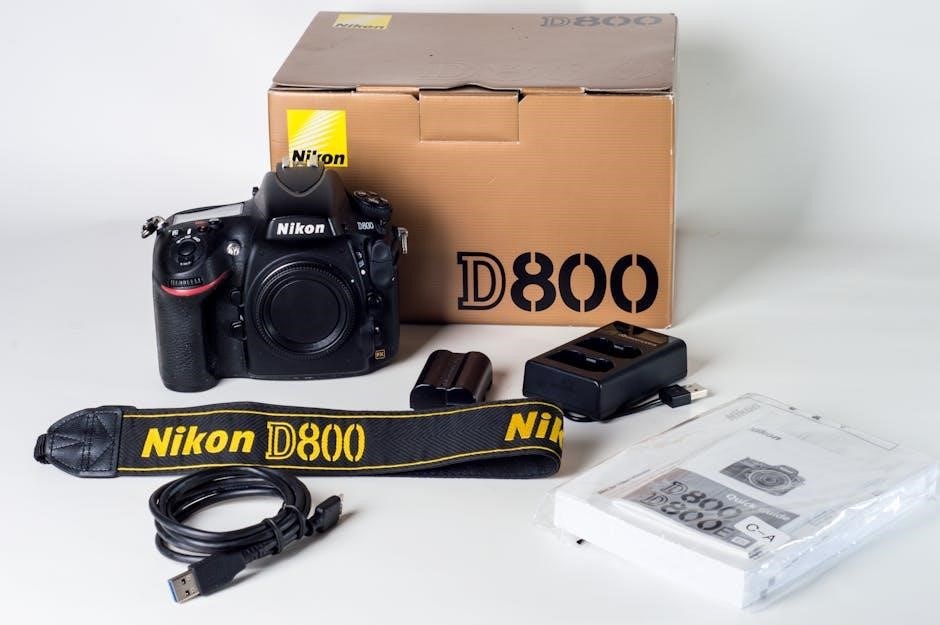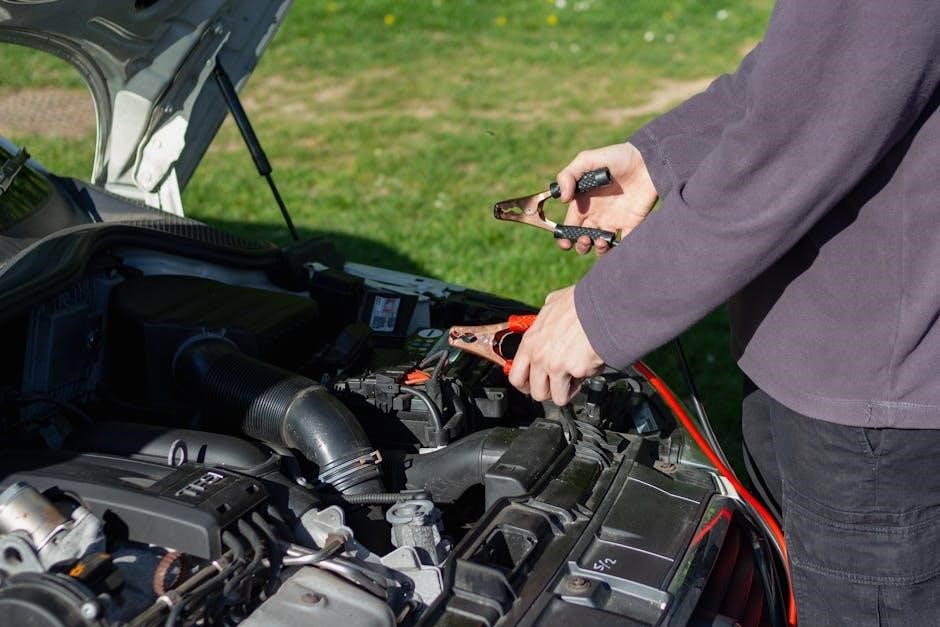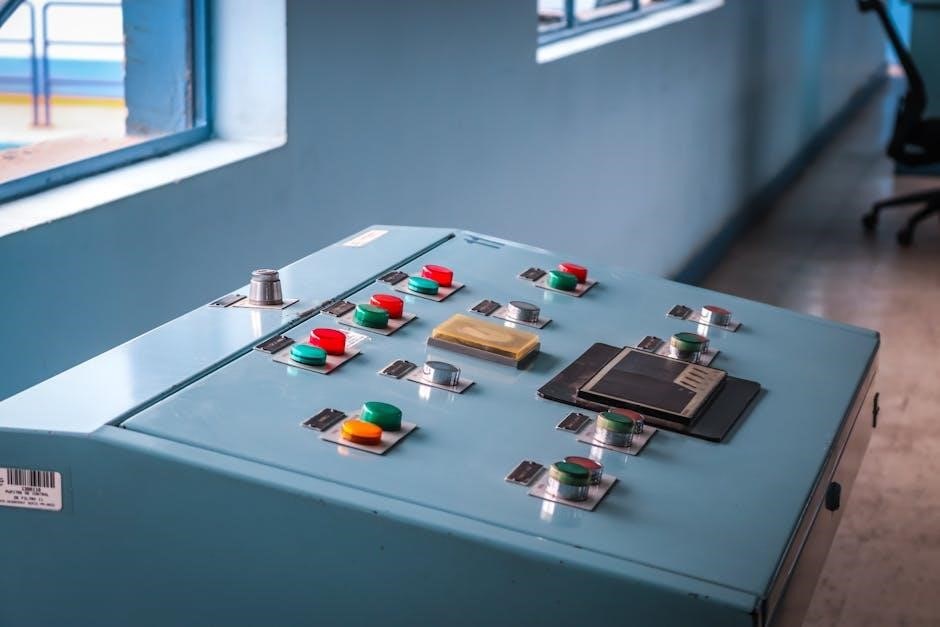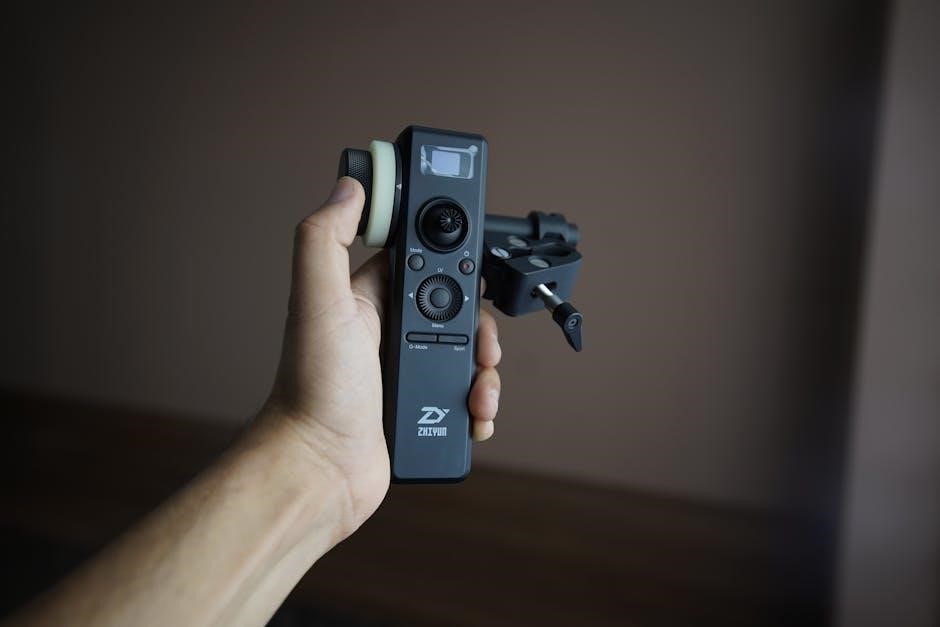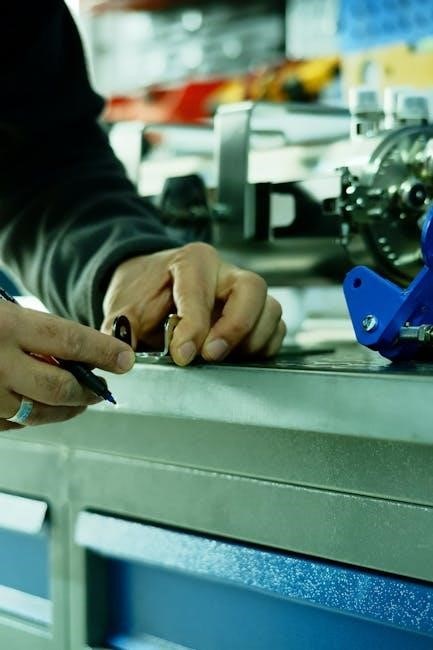mikuni carb tuning manual
Mikuni carburetors are renowned for their precision and performance, offering superior control over air-fuel mixture. Proper tuning is essential for optimal engine efficiency and power delivery. This manual provides a comprehensive guide to understanding and tuning Mikuni carbs, ensuring peak performance and reliability for various applications.
1.1 Overview of Mikuni Carburetors
Mikuni carburetors are widely recognized for their precision and versatility, offering superior control over air-fuel mixture delivery. Commonly used in motorcycles, marine engines, and high-performance vehicles, they are celebrated for their durability and tunability. Models like the HSR42 and VM series are popular among enthusiasts, with adjustments typically starting from pilot jets and needle clips. Proper tuning involves synchronizing carbs and ensuring optimal jet sizing. Resources like Joe Minton’s manual provide expert guidance, emphasizing the importance of systematic adjustments for peak performance and efficiency. Whether for racing or everyday use, Mikuni carbs remain a favorite among engine builders and tuners worldwide.
1.2 Importance of Proper Tuning
Proper tuning of Mikuni carburetors is crucial for achieving optimal engine performance, fuel efficiency, and reliability. Incorrect jetting or misadjusted components can lead to poor idle, hesitation, or even engine damage. Tuning ensures the right air-fuel mixture at all throttle positions, enhancing power delivery and reducing emissions. It also prevents issues like lean or rich conditions, which can cause overheating or decreased fuel economy. Regular tuning adjustments are necessary to adapt to changes in engine modifications, riding conditions, or worn parts. A well-tuned Mikuni carburetor maximizes the engine’s potential, making it essential for both everyday use and high-performance applications.
1.3 Brief History and Evolution
Mikuni carburetors have a rich history dating back to their establishment in Japan in 1923. Initially focusing on manufacturing motorcycle parts, Mikuni became synonymous with high-quality carburetors. Over the decades, they evolved from simple designs to sophisticated units like the VM and HSR series. Innovations such as round-slide technology and adjustable jets have made Mikuni a preferred choice for enthusiasts. Their carburetors have been used in various applications, from vintage motorcycles to high-performance racing engines. This evolution reflects Mikuni’s commitment to precision engineering and meeting the demands of advancing automotive technology.

Understanding the Basics of Mikuni Carbs
Mikuni carburetors are precision-engineered devices that deliver the optimal air-fuel mixture for combustion. They are highly regarded for their reliability and performance in various engines. Understanding their operation is crucial for effective tuning.
2.1 Components of a Mikuni Carburetor
A Mikuni carburetor consists of several key components, including the air filter, throttle valve, venturi, jets, float chamber, and needle. Each part plays a vital role in regulating airflow and fuel delivery. The float chamber ensures a consistent fuel level, while the jets and needle manage fuel flow during different engine speeds. Proper understanding of these components is essential for effective tuning and maintenance, ensuring optimal engine performance and efficiency.
2.2 Air-Fuel Mixture and Flow Path
The Mikuni carburetor regulates the air-fuel mixture by drawing air through the intake and mixing it with fuel from the jets. The flow path begins with air entering the carburetor, passing through the throttle valve, and accelerating in the venturi, which creates a vacuum to draw fuel. The fuel is delivered through the pilot, needle, and main jets, ensuring the correct mixture at different engine speeds. Proper adjustment of these components is critical to achieve the ideal air-fuel ratio, preventing lean or rich conditions that can affect performance and engine longevity.
2.3 Role of Jets and Needles
The jets and needles in a Mikuni carburetor play a crucial role in delivering the precise air-fuel mixture. The pilot jet controls fuel flow at low RPM, ensuring smooth idling and transitions. The needle, adjusted by the clip position, regulates fuel delivery in the mid-range. The main jet handles high-RPM fuel flow, impacting top-end performance. Correct sizing and adjustment of these components ensure optimal engine operation, preventing issues like hesitation or poor acceleration. Proper tuning involves testing and refining these settings to match the engine’s specific needs for improved power and efficiency.

Tools and Materials Needed for Tuning
- Screwdrivers and Allen wrenches for adjustments.
- Jetting tools and replacement jets/needles.
- Air-fuel mixture screw and drill bits.
- Gloves, safety goggles, and carb cleaner.
- Mikuni tuning manual for guidance.
- Cleaning supplies for maintenance.
3.1 Essential Tools for Carb Tuning
Essential tools for Mikuni carb tuning include screwdrivers, jetting tools, and a drill bit for air-fuel mixture adjustments. Carb cleaner is vital for maintenance, while gloves and safety goggles ensure protection. A Mikuni tuning manual provides detailed guidance, and replacement jets, needles, and gaskets are often needed. A vacuum gauge aids in synchronizing multiple carbs, and a tachometer helps monitor idle and throttle response. Proper tools ensure precise adjustments, preventing damage and optimizing performance. Always refer to the manual for specific tool recommendations and procedures to achieve accurate tuning and reliable engine operation.
3.2 Safety Precautions
When tuning Mikuni carbs, safety is paramount. Always wear protective gear, including gloves and goggles, to prevent injury from fuel splashes or debris. Ensure the work area is well-ventilated to avoid inhaling harmful fumes. Disconnect the battery and ground the bike to prevent accidental startups. Never smoke or have open flames nearby, as fuel vapors can ignite. Keep a fire extinguisher close. Properly clean and stabilize the carb before disassembly to avoid fuel spills. Follow manual instructions closely and test adjustments gradually. Neglecting safety precautions can lead to serious accidents or engine damage.
3.3 Recommended Manuals and Resources
For accurate tuning, refer to the official Mikuni Carburetor Tuning Manual, which provides detailed step-by-step instructions. Joe Minton’s guide is highly recommended, as he is a renowned expert with extensive experience. Online forums and communities, such as those dedicated to motorcycle enthusiasts, often share valuable insights and troubleshooting tips. Additionally, niche suppliers like Niche Cycle Supply and MAP Cycle offer genuine Mikuni parts and tuning guides. For specific models like the HSR42 or BS series, consult Mikuni’s official resources or reach out to specialized tuning experts for tailored advice. These resources ensure precise adjustments and optimal performance.

Step-by-Step Tuning Process
The process begins with initial setup and idle adjustment, followed by pilot jet tuning and needle clip positioning. Main jet sizing and carb synchronization ensure optimal performance.
4.1 Initial Setup and Idle Adjustment
Start by ensuring the carburetor is properly installed and aligned. Adjust the idle mixture screw to achieve a smooth idle, typically between 1-2 turns out. Warm the engine thoroughly before making adjustments; Use a clean, stable throttle to assess idle quality. If the engine hesitates or runs rough, fine-tune the screw incrementally. Proper idle adjustment lays the foundation for optimal performance across the entire RPM range.
4.2 Pilot Jet Adjustment
The pilot jet controls fuel flow at low RPM. Start with the recommended jet size from the manual. If the engine struggles or runs lean, try a larger pilot jet. Test by slowly increasing throttle from idle; smooth transition indicates correct sizing. Adjust in small increments and test each change. Proper pilot jet adjustment ensures smooth idle and efficient low-end performance, preventing issues like hesitation or stalling during acceleration. Always refer to the tuning manual for specific guidelines tailored to your Mikuni carburetor model.
4.3 Needle Clip Positioning
Adjust the needle clip to fine-tune the air-fuel mixture in the mid-RPM range. Start with the clip in the middle groove and test performance. Raising the clip enriches the mixture, while lowering it leans it out. Move the clip one groove at a time, testing each position. Ensure smooth throttle response and consistent power delivery. Fine-tune based on how the engine reacts during acceleration. Proper positioning prevents issues like bogging or surging, ensuring optimal performance across the RPM range. Always test thoroughly after each adjustment to confirm the correct setting.
4.4 Main Jet Sizing
Selecting the correct main jet size is crucial for achieving the optimal air-fuel mixture at high RPM. A larger jet allows more fuel flow, enriching the mixture, while a smaller jet restricts flow, leaning it out. Start with the manufacturer’s recommended size and test performance during full throttle. If the engine runs rich, switch to a smaller jet; if lean, choose a larger one. Use a jet sizing chart as a guide, but always fine-tune based on the engine’s response. Proper main jet sizing ensures maximum power and efficiency without damaging the engine.
4.5 Synchronizing Multiple Carbs
Synchronizing multiple Mikuni carbs ensures balanced airflow and fuel delivery across all cylinders. Start by adjusting the throttle cables to ensure synchronized movement. Use a vacuum gauge to measure intake manifold vacuum at each carb, adjusting the synch screws until readings are equal. Fine-tune by listening to engine smoothness during acceleration. Proper synchronization prevents uneven running, improves power delivery, and reduces fuel consumption. Regular checks and adjustments maintain optimal performance, especially after modifications or long rides. This step is vital for multi-carb setups to ensure the engine operates at its peak efficiency and responsiveness.

Advanced Tuning Techniques
Advanced tuning involves refining air-fuel mixtures, optimizing jetting, and modifying carbs for high-performance demands. Techniques include adjusting needle clips, exploring high-flow jets, and fine-tuning for specific conditions.
5.1 High-Performance Modifications
High-performance modifications for Mikuni carbs focus on enhancing airflow and fuel delivery. Upgrading to larger jets or high-flow needles can improve power output at higher RPMs. Installing aftermarket components like velocity stacks or modified air boots can also increase efficiency. Additionally, adjusting the carb’s venturi diameter or implementing custom jetting configurations can further optimize performance for specific engines. These modifications require precise tuning to ensure proper air-fuel balance and prevent lean or rich conditions. Always refer to expert guides or manuals for tailored adjustments.
5.2 Adjusting for Specific Riding Conditions
Adjusting Mikuni carbs for specific riding conditions ensures optimal performance. For high-altitude riding, smaller main jets and richer needle settings may be needed to compensate for thinner air. In cold climates, enriching the mixture by lowering the needle or increasing the pilot jet size can improve starting and low-speed operation. Conversely, in hot conditions, leaning the mixture slightly can prevent overheating. Riders should also consider load fluctuations, adjusting the air-fuel mixture to maintain efficiency under varying weights or terrain demands. Always test adjustments incrementally to avoid extreme lean or rich conditions.
5.3 Fine-Tuning the Air-Fuel Mixture
Fine-tuning the air-fuel mixture is critical for maximizing performance and efficiency. Start with a warm engine, as this ensures accurate adjustment. Adjust the pilot jet for smooth idling and seamless transition to the needle jet. Use the needle clip to fine-tune the mid-range fuel delivery, raising it for a richer mixture or lowering it for a leaner one. The main jet is adjusted for high-RPM performance, ensuring no hesitation or stumbling. Always test changes incrementally, monitoring for signs of lean or rich conditions. Proper fine-tuning requires patience and a systematic approach to achieve the ideal air-fuel ratio.

Common Issues and Troubleshooting
Common issues include poor idle, hesitation, or bogging, often due to improper jetting or air-fuel mixture. Systematic troubleshooting involves checking float levels, jets, and synchronization for optimal performance.
6.1 Identifying Lean and Rich Conditions
Identifying lean and rich conditions is crucial for proper tuning. A lean condition occurs when there’s too much air relative to fuel, causing symptoms like engine hesitation, reduced power, and increased temperature. This can be detected by a clean or white spark plug. Conversely, a rich condition, indicated by a fouled or black spark plug, happens when excess fuel isn’t fully burned, leading to poor idle and lower fuel efficiency. Both conditions require adjusting jets or needles to achieve the ideal air-fuel mixture for smooth engine operation.
6.2 Diagnosing Poor Idle or Hesitation
Poor idle or hesitation can signal issues within the carburetor’s lower circuits. Check the pilot jet for clogs or incorrect sizing, as this affects low RPM fuel delivery. Adjusting the air-fuel mixture screw can help, turning it out to enrich the mixture if too lean. Hesitation during throttle transition may indicate a mismatch between the pilot and needle jets. Ensure synchronizing multiple carbs and verify float levels to maintain consistent fuel flow. Testing under load and at various RPMs helps pinpoint the exact cause, guiding precise adjustments for smooth engine performance.
6.3 Addressing Bogging or Surging
Bogging or surging issues often stem from improper jetting or air-fuel mixture imbalances. Start by checking the main jet size; a jet that’s too small can cause bogging under acceleration. Enriching the mixture by raising the needle clip or installing a larger main jet may resolve this. Surging, often due to a lean condition, can be addressed by lowering the needle clip or enriching the mixture. Ensure proper synchronization of multiple carbs and verify that the float levels are correct. Testing under load and adjusting incrementally will help isolate the cause and restore smooth throttle response.
Maintenance and Upkeep
Regular cleaning with carb cleaner and rebuilding kits ensures optimal performance. Inspect for worn parts and replace as needed. Follow the service manual for detailed schedules and procedures to maintain your Mikuni carburetors in peak condition.
7.1 Cleaning and Rebuilding Carbs
Cleaning and rebuilding Mikuni carbs is crucial for maintaining performance. Start by disassembling the carburetor and soaking components in a carb cleaner. Use a soft brush to remove stubborn deposits. Inspect jets, needles, and float bowls for wear or damage. Replace any damaged parts with genuine Mikuni components. Reassemble carefully, ensuring all gaskets and seals are in good condition. Properly synchronizing and tuning post-cleaning is essential for optimal engine operation. Regular cleaning prevents fuel varnish buildup and ensures smooth airflow and fuel delivery. Always refer to the manual for specific instructions and safety precautions during the process.
7.2 Replacing Worn or Damaged Parts
Replacing worn or damaged parts in Mikuni carbs ensures optimal performance and longevity; Common replacements include jets, needles, and float valves. Always use genuine Mikuni components to maintain precision and reliability. Inspect parts like the throttle slide, diaphragm, and float bowl gasket for wear. Replace any damaged or corroded items promptly to prevent fuel leaks or air intake issues. Follow the manual’s guidelines for disassembly and reassembly to avoid further damage. Proper installation and adjustment of new parts are critical for maintaining correct air-fuel ratios and smooth engine operation. Regular inspections help identify worn parts before they cause significant problems.
7.3 Regular Inspection Schedule
A regular inspection schedule is crucial for maintaining Mikuni carburetors. Inspect jets, needles, and float valves every 1,000 to 3,000 miles or before each riding season. Check for dirt, corrosion, or wear. Clean or replace parts as needed to ensure proper airflow and fuel flow. Examine throttle cables, fuel lines, and vacuum seals for damage or leaks. Perform a thorough cleaning of the carburetor body and internal passages to prevent debris buildup. Follow the manual’s step-by-step inspection guide for specific model recommendations. Regular checks help prevent performance issues and ensure reliable engine operation. Always refer to your Mikuni manual for exact intervals and procedures.

Specialized Tuning for Specific Models
Mikuni carburetors vary by model, requiring tailored tuning approaches. The HSR42, VM Series, and BS Series each have unique specifications and expert-recommended adjustments for optimal performance.
8.1 Mikuni HSR42 Carb Tuning
The Mikuni HSR42 is a popular choice for high-performance engines, requiring precise tuning for optimal power delivery. Start by adjusting the pilot jet to ensure smooth idle and strong throttle response. The needle clip position fine-tunes the mid-range fueling, with higher clips enriching the mixture. For main jet sizing, begin with a slightly smaller jet and test at high RPM to avoid lean conditions. Synchronization of multiple carbs is critical, using vacuum gauges for balanced airflow. Expert recommendations suggest following Joe Minton’s detailed guide for HSR42 tuning, ensuring peak performance and reliability across various applications.
8.2 VM Series Carburetors
The Mikuni VM Series carburetors are known for their simplicity and versatility, making them a favorite among enthusiasts. Tuning the VM Series involves adjusting the float height to ensure proper fuel levels, followed by pilot jet sizing for smooth idle and low-end response. The main jet is typically sized based on engine displacement and airflow, with adjustments made through thorough testing. Needle clip positioning fine-tunes the mid-range, while synchronization ensures balanced operation in multi-carb setups. Resources like Joe Minton’s guides provide detailed insights, helping users optimize performance and reliability for both vintage and modern applications.
8.3 BS Series Carburetors
Tuning Mikuni BS Series carburetors requires precise adjustments to achieve optimal performance. Start with the pilot jet to ensure smooth idle and transition to the needle jet. Adjust the needle clip position to fine-tune the mid-range fuel delivery. Main jet sizing depends on engine specifications and performance needs. Synchronization of multiple carbs is crucial for balanced operation. Referencing Joe Minton’s manual or specific BS Series guides provides detailed steps and expert advice, helping enthusiasts maximize power and efficiency while maintaining reliability for both racing and everyday riding conditions.

Resources and Further Reading
Consult Joe Minton’s tuning manual for expert guidance. Online forums and communities offer valuable insights. Niche Cycle Supply and MAP Cycle provide genuine Mikuni parts and support.
9.1 Recommended Manuals and Guides
Joe Minton’s Mikuni carburetor tuning manual is a cornerstone for enthusiasts, offering detailed instructions and expert insights. The HSR tuning books are highly recommended for Harley-Davidson applications. Additionally, niche resources like the Mikuni SBN manual provide specific guidance for marine and off-road tuning. Online forums and communities, such as those dedicated to vintage British and Japanese motorcycles, often share valuable tuning tips and tricks. For comprehensive understanding, consult the official Mikuni CarbTuningManual in digital format, available through trusted suppliers. These resources are essential for both beginners and experienced tuners seeking to master Mikuni carburetors.
9.2 Online Forums and Communities
Online forums are invaluable for Mikuni carb tuning, offering real-time interaction and shared knowledge. Communities like Reddit’s r/Motorcycles and specialized vintage bike forums provide platforms for enthusiasts to exchange tips and solutions. Experts and experienced tuners frequently contribute, offering insights and troubleshooting advice. These forums are particularly useful for addressing model-specific challenges and rare configurations. Many users share detailed tuning experiences, creating a wealth of crowd-sourced knowledge. Active participation in these communities can accelerate learning and problem-solving, making them essential resources for both beginners and seasoned tuners.
9.3 Expert Advice and Tips
Expert advice is crucial for mastering Mikuni carb tuning. Leading authorities like Joe Minton, with decades of experience, provide insights through detailed manuals and guides. Start by referencing the official Mikuni tuning manual, as it offers baseline configurations and procedures. Experts recommend beginning with the pilot jet adjustment to ensure smooth idle and transition. Adjusting the needle clip position can significantly impact mid-range performance. Always test adjustments incrementally and monitor engine response. Rely on proven methods and seek guidance from experienced tuners to avoid common pitfalls and achieve optimal results.
Mikuni carb tuning is an art requiring patience and precision. Proper adjustments enhance performance and reliability. Continuous learning and expert guidance ensure mastery. Happy tuning!
10.1 Final Thoughts on Mikuni Carb Tuning
Mikuni carburetors offer unparalleled precision and performance when tuned correctly. Mastering their adjustment requires patience, skill, and a deep understanding of air-fuel dynamics. Proper setup ensures optimal engine efficiency, power delivery, and reliability. Always refer to the official manual and seek expert advice for specific models. Tuning is a process of trial and error, and persistence is key. With practice, you’ll unlock the full potential of your Mikuni carbs. Remember, continuous learning and adaptation are crucial for achieving the perfect tune. Happy tuning, and enjoy the ride!
10.2 Encouragement for Continuous Learning
Continuous learning is key to mastering Mikuni carb tuning. Stay updated with new techniques and resources to refine your skills. Explore manuals, online forums, and expert advice to deepen your understanding. The Mikuni community is vast and supportive, offering invaluable insights and tips. Embrace challenges as opportunities to grow and improve. With dedication, you’ll become proficient in tuning for any condition or model. Keep experimenting, learning, and adapting to unlock the full potential of your Mikuni carbs. The journey of learning is rewarding, and the results will enhance your riding experience.









